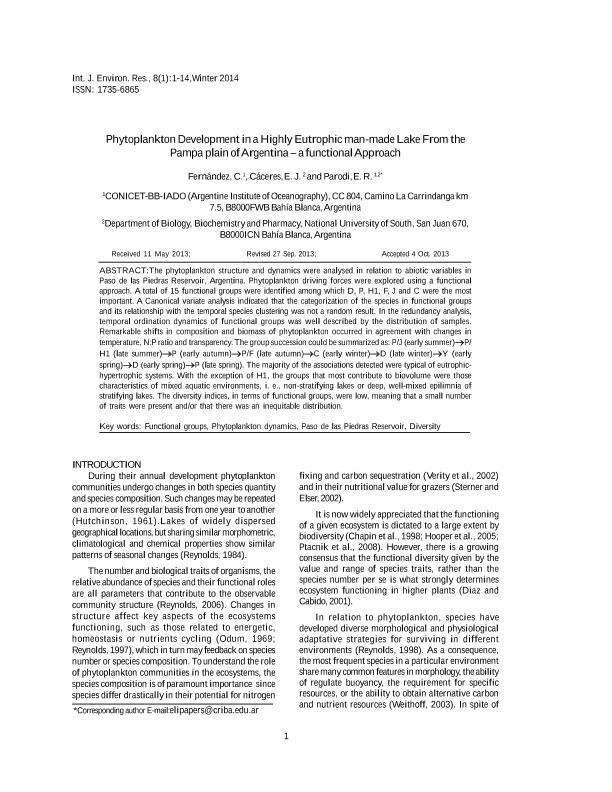Mostrar el registro sencillo del ítem
dc.contributor.author
Fernández, C.
dc.contributor.author
Cáceres, E. J.
dc.contributor.author
Parodi, Elisa Rosalia

dc.date.available
2017-01-13T21:40:49Z
dc.date.issued
2014-02
dc.identifier.citation
Fernández, C.; Cáceres, E. J.; Parodi, Elisa Rosalia; Phytoplankton development in a highly eutrophic man-made lake from the Pampa plain of Argentina. a functional approach; Univ Tehran; International Journal Of Environmental Research; 8; 2-2014; 1-14
dc.identifier.issn
1735-6865
dc.identifier.uri
http://hdl.handle.net/11336/11368
dc.description.abstract
The phytoplankton structure and dynamics were analysed in relation to abiotic variables in Paso de las Piedras Reservoir, Argentina. Phytoplankton driving forces were explored using a functional approach. A total of 15 functional groups were identified among which D, P, H1, F, J and C were the most important. A Canonical variate analysis indicated that the categorization of the species in functional groups and its relationship with the temporal species clustering was not a random result. In the redundancy analysis, temporal ordination dynamics of functional groups was well described by the distribution of samples. Remarkable shifts in composition and biomass of phytoplankton occurred in agreement with changes in temperature, N:P ratio and transparency. The group succession could be summarized as: P/J (early summer)→P/ H1 (late summer)→P (early autumn)→P/F (late autumn)→C (early winter)→D (late winter)→Y (early spring)→D (early spring)→P (late spring). The majority of the associations detected were typical of eutrophichypertrophic systems. With the exception of H1, the groups that most contribute to biovolume were those characteristics of mixed aquatic environments, i. e., non-stratifying lakes or deep, well-mixed epilimnia of stratifying lakes. The diversity indices, in terms of functional groups, were low, meaning that a small number of traits were present and/or that there was an inequitable distribution.
dc.format
application/pdf
dc.language.iso
eng
dc.publisher
Univ Tehran

dc.rights
info:eu-repo/semantics/openAccess
dc.rights.uri
https://creativecommons.org/licenses/by-nc-sa/2.5/ar/
dc.subject
Functional Groups
dc.subject
Phytoplankton Dynamics
dc.subject
Paso de Las Piedras Reservoir
dc.subject
Diversity
dc.subject.classification
Biología Marina, Limnología

dc.subject.classification
Ciencias Biológicas

dc.subject.classification
CIENCIAS NATURALES Y EXACTAS

dc.title
Phytoplankton development in a highly eutrophic man-made lake from the Pampa plain of Argentina. a functional approach
dc.type
info:eu-repo/semantics/article
dc.type
info:ar-repo/semantics/artículo
dc.type
info:eu-repo/semantics/publishedVersion
dc.date.updated
2016-12-01T19:39:13Z
dc.journal.number
8
dc.journal.pagination
1-14
dc.journal.pais
Irán

dc.journal.ciudad
Tehran
dc.description.fil
Fil: Fernández, C.. Consejo Nacional de Investigaciones Científicas y Técnicas. Centro Científico Tecnológico Bahía Blanca. Instituto Argentino de Oceanografía (i); Argentina
dc.description.fil
Fil: Cáceres, E. J.. Universidad Nacional del Sur. Departamento de Biología, Bioquímica y Farmacia; Argentina
dc.description.fil
Fil: Parodi, Elisa Rosalia. Universidad Nacional del Sur. Departamento de Biología, Bioquímica y Farmacia; Argentina. Consejo Nacional de Investigaciones Científicas y Técnicas. Centro Científico Tecnológico Bahía Blanca. Instituto Argentino de Oceanografía (i); Argentina
dc.journal.title
International Journal Of Environmental Research

dc.relation.alternativeid
info:eu-repo/semantics/altIdentifier/url/https://ijer.ut.ac.ir/article_689.html
Archivos asociados
